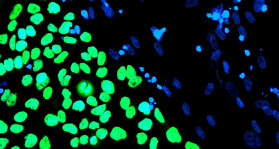
Stem cell promise R. PRASAD
| The science of stem cells is still in its infancy. But the U.S. government may start providing more fund for research giving hope for the way medicine would be practised in the future. |

The U.S. President Barack Obama was in the news recently for signing the Executive Order reversing the former President’s August 9, 2001 policy of providing limited federal funding for embryonic stem cell research.
Restrained by limited federal funding, scientists were denied the opportunity to research embryonic stem cells that hold great promise to treat many injuries and diseases using a totally different approach.
We already know that doctors regularly treat children suffering from leukaemia — a kind of blood cancer — by injecting a special kind of cells separated from the bone marrow of a healthy person. These special cells are called “stem cells”.
Stem cells are the master cells that are found in every individual. There are basically two kinds of stem cells. One is called embryonic stem cells and the other is adult stem cells.
Embryonic stem cells are found in a four to five-day-old dividing bunch of cells. They are capable of becoming any of the 250-odd cells such as muscles, nerves, bone and fat cells.
Photo : Reuters and AFP

Unravelling the mysteries : A human embryonic stem cell line; Preparing stem cells for culture.
Stem cells are also found in adults in certain organs such as fat, brain, skin. These are called “adult stem cells”. The stem cells used for treating leukaemia in children are adult stem cells.
Greater hope
The main difference between embryonic and adult stem cells is that while embryonic stem cells can become any adult cell, adult stem cells can only become the organ specific cell in which they are found. For example, stem cells present in the skin can become only skin cells.
But scientists have achieved some success to make adult stem cells found in a specific organ, say fat, become another cell kind. But it is believed that adult stem cells would be far inferior to embryonic stem cells in their ability to become any other cell type.
These precisely are the reasons why scientists feel that embryonic stem cells hold greater promise to treat spinal cord injuries and many diseases such as diabetes, Parkinson’s and Alzheimer’s.
There is yet another kind of research being actively pursued by scientists. They are working on ordinary adult cells to make them behave like stem cells. Scientists tasted their first success two years ago when they were able to reprogramme ordinary skin cells to behave like embryonic stem cells. These reprogrammed cells are called “induced pluripotent stem cells” (iPS cells).
The science of stem cells, both embryonic and adult, is still in its infancy. While adult stem cell research has progressed in these last eight years, research on embryonic stem cells has been stifled due to limited federal funding.
All that is about to change as the U.S. government would start providing more funding for embryonic stem cell research. There is now a greater hope that the way medicine would be practised in the future may be totally different.
Centres where research on stem cells is carried out:
Christian Medical College (CMC), Vellore
L.V. Prasad Eye Institute, Hyderabad
Manipal Institute of Regenerative Medicine, Bangalore
National Centre for Cell Science, Pune
Sankara Nethralaya, Chennai
Nichi-In Centre for Regenerative Medicine, Chennai
For further reading
1. The U.S. National Institutes of Health (NIH): http://stemcells.nih.gov/info/basics/ and
http://stemcells.nih.gov/info/basics/basics1.asp
2. The U.S. National Academy of Science: http://dels.nas.edu/bls/stemcells/basics.shtml
3. The International Society of Stem Cell Research (ISSCR):
http://www.isscr.org/public/escells.htm and http://www.isscr.org/public/faq.htm
|


